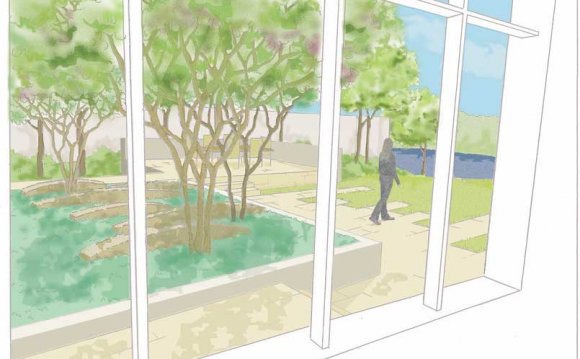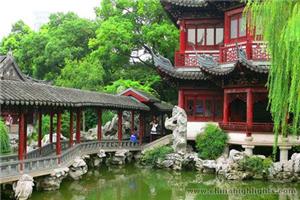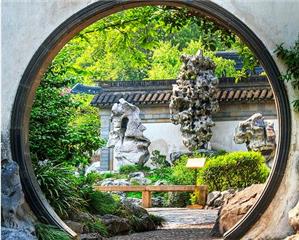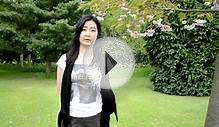
 Chinese gardens blend unique architectures with natural elements.
Chinese gardens blend unique architectures with natural elements.
Chinese gardens are constructed to recreate and miniaturize larger natural landscapes. Traditionally, Chinese gardens blend unique, ornate buildings with natural elements.
Just about every Chinese garden contains architecture, like a building or pavilion; decorative rocks and a rock garden; plants, trees and flowers; and water elements, like ponds. Most Chinese gardens are enclosed by a wall and some have winding paths.
Chinese gardens aren’t just thrown together. Instead, they’re deliberately designed and visitors should walk through them in the particular order that the garden was laid out.
The History of Chinese Gardens
For the past 3, 000 years, everyone in China, from emperors and government officials to scholars and poets, have built their own Chinese garden. The first Chinese gardens were built in the Yellow River valley. Kings and members of the nobility during the Shang Dynasty (1600–1046 BC) hunted and planted fruits and vegetables in their gardens. There were two types of gardens: one where animals were kept and one for plants and gardening.
Layout and Design of Classic Chinese Gardens
Every scene in Chinese garden is well-planned.Chinese gardens aren’t laid out in a way that you can see the entire garden all at once. Instead, small scenes are set up so that as you wander through the garden, you come upon several intimate settings to view. Every scene is well-planned and framed.
Some elements that aren’t actually in the garden are part of the design as well. For example, some gardens purposely have a view of a mountain from one of its many scenes.
Chinese Garden Walls and Enclosures
Classical Chinese gardens were surrounded by a white wall. The stark color contrast sets a nice backdrop for the trees and flowers. Green leaves and colorful blooms really stand out against a white setting.
Having a wall surrounding a garden makes the area seem secluded, even if it’s not. Sectioning off the garden makes the elements of the area stick out and appear even more vibrant. Walls will also block out surrounding buildings that would otherwise interfere with the serenity of the garden.
 Architecture in a Chinese Garden
Architecture in a Chinese Garden
Unique architecture in a Chinese Garden
The types of buildings that are included in a Chinese garden have to do with whose garden it is. For example, a scholar may have a library in their garden. Some buildings have connected hallways and pavilions, each of which will have a view of a different area of the garden. Other Chinese gardens have temples, bridges, galleries and towers.
Ideally, the buildings and structures in a Chinese garden will complement the setting instead of dominating it. The larger the garden, the more buildings it will contain.
Types of Structures
Ceremony halls, located near the entrance of the garden, have their own courtyard and are used for family celebrations. Principal Pavilions are for receiving guests and celebrating big holidays with a large crowd.
The Pavilion of Flowers is traditionally close to the residential home and is filled with flowers and plants. Some flower pavilions will have a small rock garden as well.
Pavilions with movable walls offer a panoramic view of the entire garden. Large gardens will have guest rooms and housing.
Seasonal Pavilions
Some gardens contain a Pavilion of Mandarin Ducks, which is divided into two seasonal sections. One section will face north, toward a lotus pond. Cool air will blow into this part of the pavilion during the summertime. The other section will face south, toward a pine tree-filled courtyard and plum trees. When the plum trees blossom, it means that spring is on the way.
There will also be a pavilion set up for viewing autumn foliage and small pavilions to escape to when it rains.
Rock Gardens and Rock Decor
Every Chinese garden has some type of rock element. Some designers opt for a simple rock garden, while others construct miniature mountains from a collection of rocks. Sometimes gardeners make mountains from both rocks and dirt. Large, classic Chinese gardens will have a huge faux mountain with a pavilion located at the summit.
Rocks are chosen based on their shape, texture, substance, color and softness. Limestone rocks that have taken strange shapes due to erosion are among the most valued rocks for Chinese gardeners.
Meaning of Rock Mountains
Including a miniature mountain in the Chinese garden isn’t just for esthetic appeal. Mountains have symbolic meaning in Chinese culture, too. Mountain peaks symbolize virtue and stability. They also symbolize belief in the philosophy laid out by Confucius. Also, the legend of the Isles of the Immortals had a mountain peak as its main focus point, which is why the mountain is a central unit in several Chinese gardens.
Plants, Flowers and Trees
Green trees in Yu Garden, a famous garden in ShanghaiPlants are chosen carefully, dependent on their texture, shape, color and fragrance. Some Chinese gardens have a lotus pond with a nearby lotus pavilion. Chinese gardeners choose the different plant elements for their garden largely due to fragrance.
Chinese gardens typically always have fragrant flowers to set the atmosphere. Flowers and trees also contrast with sharp, harsh architectural lines. Sound is another element of Chinese gardens, and when rain falls on the leaves of trees and bushes, it creates a soothing sound.
Water Elements
The most common water element of a Chinese garden is a pond. The pond is usually situated in the center of the garden. Larger gardens will have a lake instead of a pond. The other elements of the garden will be arranged around the pond. Some ponds have fish in them, like goldfish.
In China, water symbolizes communication and dreams. A water element is also a welcome complement to the rock garden and mountains.
YOU MIGHT ALSO LIKE












